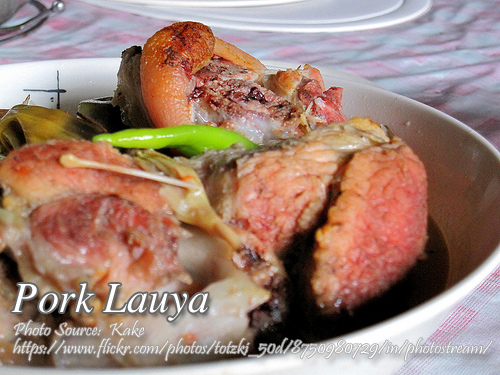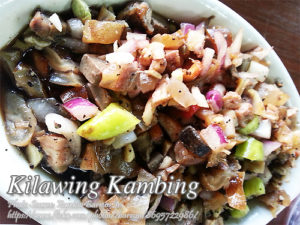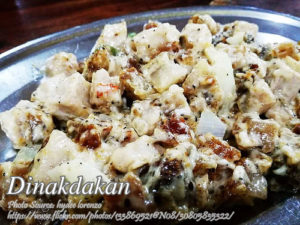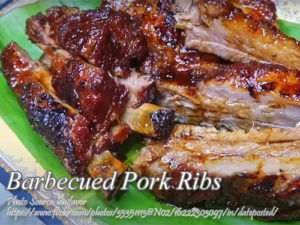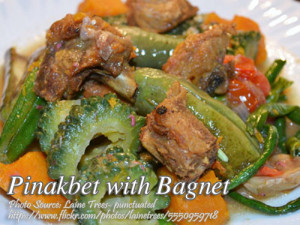Cooking pork lauya is simple, just throw everything in the pot then put it on the stove and cook. But this recipe has one more step of smoking the pork knuckles (cold smoke process) that will give the meat a more savory country style flavor. With regard to smoking the meat, don’t use scrap wood like those used in construction or furniture because they have chemicals to treat the wood. Use only natural unprocessed wood like branches of a tree or firewood. You can also grill the knuckles if smoking seems tedious to do.
Pork Lauya: A Nostalgic Taste of Home and Tradition
When I think of pork lauya, my mind drifts back to summers spent in Ilocos Norte with my Uncle Mario, who always believed in cooking with heart and heritage. Every time he made this hearty pork knuckle stew, the aroma would linger in the air, mingling with stories of our ancestors, the sound of laughter, and the comforting scent of the provincial breeze. He had a secret method that made his lauya unforgettable—a step that elevated its rich, meaty flavor: smoking the pork knuckles.
The Heart of Pork Lauya: Smoked Pork Knuckles
Traditionally, lauya is a dish that symbolizes comfort, simplicity, and resourcefulness. My uncle would spend hours explaining why it was worth taking that extra step to smoke the pork. “It adds a depth of flavor you can’t get any other way,” he would say, his voice tinged with pride. Smoking the meat brings a savory, slightly earthy quality that transforms the broth into something far more than just soup—it becomes a memory in every spoonful.
For beginners, this may sound intimidating, but trust me, it’s simpler than it seems. Cold smoking involves letting the pork knuckles absorb the natural smoky flavor without cooking them. If you’re new to this, ensure you use untreated, natural wood—branches from fruit trees like guava or mango work wonders. Construction wood is a big no-no because it’s treated with chemicals that can ruin the dish and even be harmful. And if smoking feels like too much work, grilling the pork knuckles is a great alternative that still imparts a rustic flavor.
Building the Foundation of Flavor
Once the pork knuckles are prepped, the rest of the process is delightfully straightforward. Toss the smoked or grilled knuckles into a large wok or pot, letting them sizzle gently before adding the key ingredients: onions, garlic, potatoes, and cabbage. A simple combination, yet each element contributes to the dish’s robust character. There’s no stirring involved at this stage, and for good reason. My Aunt Celia, a patient cook who always believed in “gentle cooking,” would remind me that stirring too early disturbs the clarity of the broth and muddles the flavors.
The balance of patis (fish sauce) and ground black pepper enhances the natural taste of the pork. While bay leaves add a subtle herbal note, the patis deepens the umami profile, blending with the smoky undertones of the knuckles.
The Ilocano Twist: Sukang Iloko
What sets Ilocano-style pork lauya apart from other pork stews is the addition of sukang Iloko—a dark, robust sugarcane vinegar with a sharp yet slightly sweet kick. My cousin Jenny once explained how vinegar wasn’t just a flavor enhancer; it was a way of life in Ilocos. It cuts through the richness of the pork, creating a beautifully balanced broth that’s both tangy and savory.
After simmering for two hours to achieve fork-tender meat, the sukang Iloko is added in the final stretch of cooking. Again, no stirring—just patience. The vinegar needs time to meld with the broth without overpowering it, which is why it’s essential to let it cook for at least another 25 minutes. This patience pays off when you taste the final product, with layers of flavor unfolding in every bite.
A Dish Rooted in History and Community
Pork lauya is more than just a dish; it’s a story passed down through generations, a culinary legacy that binds families together. Its origins lie in the resourcefulness of Ilocano families, using every part of the pig to create a meal that’s nourishing and satisfying. The pork knuckles, often considered a tough cut, are transformed into a tender, flavorful centerpiece with the right techniques.
In many ways, making lauya is like revisiting those cherished family moments. Every whiff of that smoky, tangy broth reminds me of long afternoons spent with my relatives, seated around a large wooden table, enjoying the simple pleasure of good food and even better company.
Bringing Pork Lauya Into Your Kitchen
If you’re ready to bring this nostalgic Ilocano dish into your home, remember that it’s all about the care you put into each step. From choosing quality pork knuckles to letting the broth simmer without interference, every detail matters. And don’t forget the sukang Iloko—it’s the soul of the dish, the finishing touch that ties everything together.
So the next time you’re craving a comforting, hearty stew, consider making pork lauya. Not only will it fill your kitchen with mouthwatering aromas, but it will also give you a taste of Filipino history, one bowl at a time.
How to Cook Pork Lauya (Ilokano Pork Knuckles Stew)
Ingredients
- 3 kilos pork knuckes or pata ng baboy
- 1 head cabbage sliced into strips
- 4 large potatoes peeled and quartered
- 1 head garlic crushed
- 4 pcs medium size onions chopped
- 6 pcs crushed bay leaves
- 1 Tbsp. ground black pepper
- 3/4 cup patis or fish sauce
- 1/8 cup sukang Iloko raw sugarcane vinegar
- 4 liters water or soup stock
- MSG or any granulated seasoning to taste
Instructions
How to Cook Pork Lauya:
- Chop the pork knuckles or let the meat vendor chop it for you about 1 and 1/2 inches thick.
- Wash and clean the pork knuckles, remove or shave the small hairs if you found any.
- Then smoke the pork knuckles using the cold smoke process. You can also grill the pork partially to improve the taste if you don't want to smoke it. Set aside.
- Heat a big wok in medium to strong fire, then add the smoked pork knuckles, let it sizzle for a few seconds then add onion and garlic, potatoes, cabbage, ground black pepper, bay leaves, patis and water. Do not mix or stir.
- Cook for 2 hours or until the meat becomes tender.
- Then add sugarcane vinegar or sukang Iloko and cook for another 25 minutes. Again do not mix or stir. Serve hot in a soup plate.
Notes
Cooking Tips:
Use the Right Wood for Smoking
When smoking the pork knuckles, always choose natural, untreated wood like fruit tree branches for a clean, smoky flavor. Avoid using scrap or construction wood as it may contain harmful chemicals that can ruin the taste and safety of your dish. Smoking enhances the depth of flavor, giving the broth a rich, earthy aroma that elevates the traditional lauya.Avoid Stirring to Maintain Broth Clarity
Resist the urge to stir the pot while cooking to keep the broth clear and well-balanced. Stirring too early can agitate the ingredients, causing the broth to become cloudy and muddling the distinct layers of flavor. This technique ensures that the rich, smoky essence of the pork knuckles infuses gently into the broth.Add Sukang Iloko at the Right Time
Adding sukang Iloko during the final 25 minutes of cooking prevents the vinegar from overpowering the dish while allowing it to enhance the broth’s complexity. Letting it simmer without stirring allows the vinegar to blend naturally, balancing the rich pork flavors with a tangy kick. This timing creates a harmonious balance between the smoky, savory, and tangy notes in the stew.
